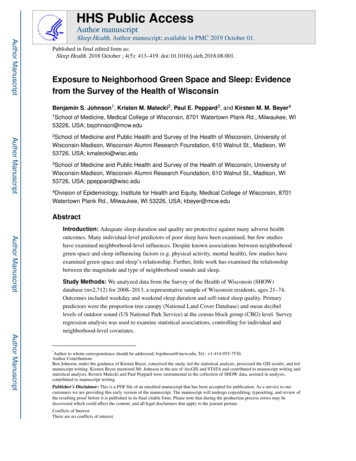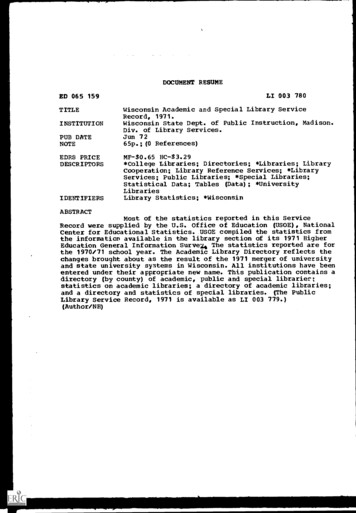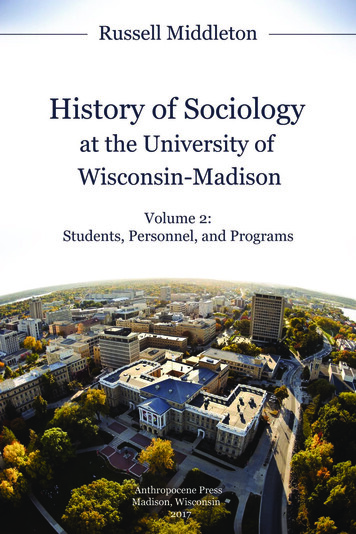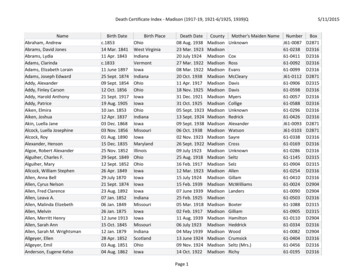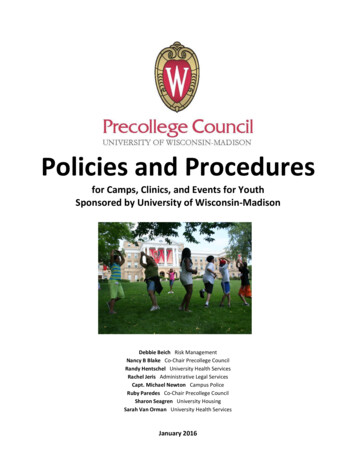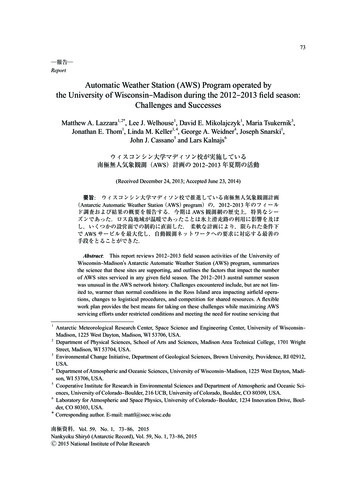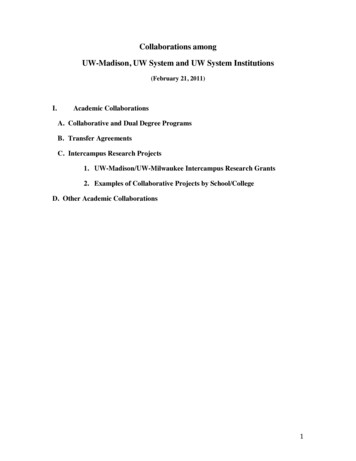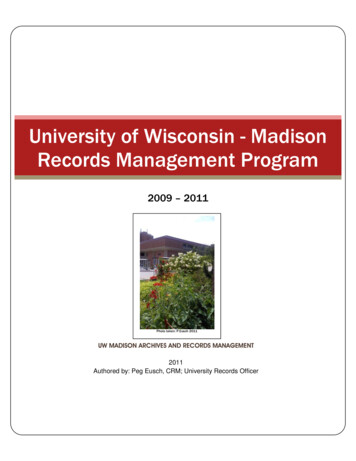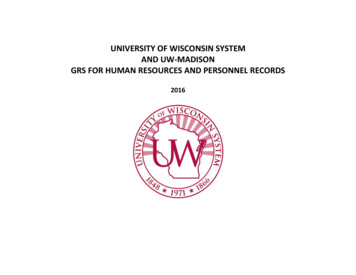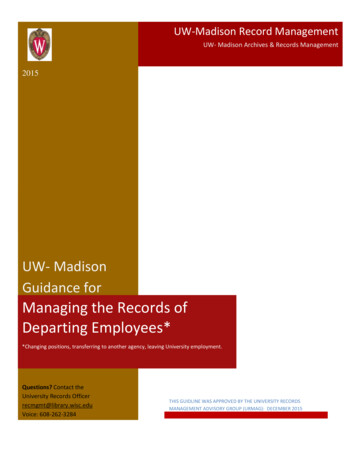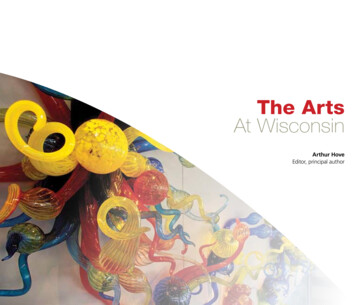
Transcription
Metro Transit2014 in Review
Metro Transit16Annual Fixed Route Ridership 1970 - Annual Boardings in Millions2014 Annual ReportMetro Transit experienced another successful and record-breaking year in 2014.In contrast to what is occurring at other transit systems throughout Wisconsin, Metro Transit set anotherridership record in 2014. Metro tallied more than 15.2 million rides last year, compared to 14.7 million ridesin 2013. This ridership is the first time Metro has surpassed more than 15 million rides in a single year.Metro Transit’s continued increase in ridership can be attributed to a number of factors some of whichinclude an overall increase in population density, an expansion of downtown high rise apartment buildings,and a large level of Millennials living in Metro’s core service area.According to a 2014 report Millennials in Motion released by the U.S. Public Interest Research Group (U.S.PIRG), the Millennial generation is less car-focused than older Americans and previous generations of youngpeople. Young Americans drive less and use public transportation more.With the University of Wisconsin and an ever-increasing number of start-up tech companies centralized inthe downtown area, along with software company Epic Systems in neighboring Verona, Madison is becoming the type of community where young people want to live.In addition, the use of smartphones to plan trips and track buses continues to make it easier and moreefficient to ride the bus each year.
Challenges Due to RidershipAlong with its success in 2014, Metro is also faced with a new set of challenges that is different than othersystems around the state.Metro’s two largest passenger complaints are that buses are overcrowded and drivers are not able to maintain their schedules. As a result, riders are not able to make their connections to other routes or are late tojobs or appointments. With this ever-increasing ridership, more and more people are boarding and exitingthe bus, which causes delays at each stop. Each delay causes the bus to get further and further behind to thepoint it can no longer make connections with other routes.Peak-Hour Service Expansions No Longer PossibleAnother factor that has attributed to high ridership and sets Metro apart in Wisconsin is that Metro hasbeen adding, not reducing, service in the past years to keep up with demand.In 2013, service was added to serve underserved neighborhoods, help address overcrowding in Madison’sbusy downtown corridor, and accommodate additional service requests from Epic Systems in Verona.In 2014, Metro again increased service out to the Epic Campus. A new Route 49 was also created addingservice out to Fitchburg. Additional service was also added to Metro’s busy Route 50.In 2015, Metro is planning to add service to the UW Health at The American Center hospital facility onMadison’s far east side.Following this 2015 service addition, Metro expects that its ability to expand service during peak hours hascome to an end. Due to lack of funding for additional buses or a much-needed bus garage, and with noregional authority funding structure in place, Metro will not be able to accommodate requests from itscustomers or contracting partners for additional peak-hour service.
Need for Regional Transit AuthorityMore than ever before, Metro Transit is in need of funding to grow the transit infrastructure in the Madisonarea. Staff are seeking the approval of a potential regional transit authority, which would further provide thefunding and governance structures needed to better serve the increasing transit needs of the community.Continued Need for a Bus Rapid Transit System (BRT)To address issues created by this ever-increasing demand for service, Metro Transit staff continue to explorethe possibilities of implementing a Bus Rapid Transit System (BRT) in the Madison area.A BRT is a high-frequency limited-stop transit system that offers faster more direct service using largervehicles to increase capacity.Transit Development PlanIn 2013, the Madison Area Transportation Planning Board (MPO) released a report that outlined the framework of its long-range regional transportation plan for Madison. This 2013-2017 Transit Development Planfor the Madison Urban Area recommended that a BRT could help the City achieve its long-term strategictransportation planning and urban development goals.Metro is looking for the Madison Common Council to accept this report in the coming year and authorizeMetro to move forward on next phases of development, environmental evaluation, and project implementation of this type of system.Bus Size StudyIn 2014, a bus size study was also completed that examined the efficiency and effectiveness of Metro’s vehiclesize.The purpose of this study was to determine if Metro could use larger or smaller buses to address overcrowding, operate more efficiently, and better serve the community. Historically, Metro Transit has used only onestandard bus size to meet the transit needs of the Madison area.The study included an analysis of existing bus services and identified routes that, based on ridership, couldwarrant the use larger articulated buses or could be better served with smaller, more fuel efficient buses.In addition, the study assessed the financial and operational impacts that could result from developing atransit fleet which features varied bus sizes and seating capacity.Finally the study made recommendations on next steps that Madison should take as it decides whether ornot to introduce vehicles of different sizes.This study specifically recommended the purchase of 40 larger articulated buses to help address scheduleand capacity problems.
U.S. Senator Tammy Baldwin Announces 300,000 in TIGER Grant Funding for MadisonTransportation ProjectIn 2014, Senator Tammy Baldwin announced that the City of Madison had been awarded 300,000 inTIGER grant funds for the UrbanFootprint Transit-Oriented Development Station Area Planning Initiative.“The UrbanFootprint Initiative will set the stage for the expansion of a Bus Rapid Transit System in Madison,remove transportation barriers and increase economic mobility throughout the city, improving the quality oflife for Madison residents," Baldwin said in a news release.This TIGER grant allows the City of Madison to undertake scenario planning and prepare detailed transitoriented neighborhood and station area corridor plans for three key areas to be served by a bus rapid transitsystem.Need for New Maintenance FacilityIn addition to addressing Metro’s ridership challenges through the creation of a BRT, Metro is also in need ofadditional funding to undertake the construction of a much-needed bus garage.Metro currently houses 214 full-sized buses and 17 paratransit vehicles in a garage designed to only hold 160vehicles. Even if funding were available to purchase extra buses, Metro currently does not have the space tostore them.Potential Site on Nakoosa TrailStaff have identified a site on City of Madison property on the east side of Madison for a potential facility.The possibilities of a maintenance facility on this site are currently making their way through the City’splanning and building process.This site is not shovel-ready, but is in planning stages. Metro staff are working to identify additional TIGERgrant funding to finance its construction. This potential facility is expected to hold approximately 70 buses,and staff hope it will be completed in the next three to five years.Search for Temporary Facility to LeaseIn addition to this property, Metro staff are also looking for existing garage space to lease for approximately10-15 buses until a larger facility can be built. Conversations on this project are ongoing with the Mayor’soffice and City of Madison staff.
Bus Stop Consolidation ProjectIn 2014, staff also began looking at ways utilizing existing resources to address its chronic schedule issuesresulting from high ridership and overcrowded buses.Based on an analysis of bus stop spacing along Madison’s central transit corridors, it was determined thatthere are a number of stops placed excessively close together. These stops result in a higher number of startsand stops that increase travel time. To streamline the number of stops in the system and attempt to slightlyimprove on-time performance in these areas, Metro staff began implementing a bus stop consolidationprogram.Stop reductions on certain street segments have been implemented. Others have been placed under reviewfor public comment. After public comment, decisions are made on whether to remove or maintain theseparticular stops at their current locations.Paratransit Service Implements In-Person AssessmentsIn the Spring of 2014, Metro updated its strictly paper-orientated paper paratransit application process byintroducing in-person assessments to determine eligibility. Switching to in-person assessments removedmany different factors that had the potential to negatively affect a person’s ability to be certified for paratransit service.Some of these potential factors include inability to type, poor handwriting, lack of skill in filling out forms,and/or inexperienced caregiver staff that might just be learning the process of getting someone certified.To make the process more fair to the applicant, Metro hired and trained a staff person to conduct in-personassessments at Metro’s administration offices.In-person assessments involve a short paper application and a brief in-person interview with this staffperson. This process allows the applicant an opportunity to discuss their mobility needs and abilities beforean eligibility determination is made.In-person assessments are now being used for all new eligibility determinations as well as for the recertification process of current riders.
New FareboxesUsing federal grant money awarded in 2011 aimed at modernizing the nation’s transit infrastructure, newelectronic fareboxes were installed on all fixed-route buses in June.New fareboxes replaced units that were more than 20 years old and had exceeded their useful life. Thesenew fareboxes are expected to help lower maintenance costs, increase customer convenience with quickerboardings, improve ridership data, and give the opportunity to upgrade sometime in the future to smart cardtechnology.Quick Tix Trade-InAs part of this new farebox installation, it was determined that paper quick tix couldn’t be used in the newequipment’s bill acceptor. As a result, customers were asked to trade in quick tix for magnetic strip cards thatwould be compatible with the farebox. Drivers accepted paper quick tix through October to allow passengerstime to trade in their remaining inventory.
Safety InitiativesSafe Streets Press ConferenceOn November 3, Mayor Paul Soglin and Metro Transit General Manager Chuck Kamp held a press conference to release a video compiled of safety-related incidents captured by bus surveillance cameras.Mayor Soglin and Chuck Kamp discussed incidents seen in this video to raise awareness and encourageeveryone in the community to share Madison streets safely.The goal of this press conference is to increase safety for everyone, and prevent accidents,” Kamp said at theevent. “If by releasing this video we were able to raise awareness enough to even prevent one bad accident,then we would consider this outreach a success.”Metro plans to use bus surveillance video for future public outreach in an attempt to help minimize seriousaccidents to the point that they rarely or never happen again.Audible Turn SignalsAnother safety initiative Metro undertook in 2014 was the installation of audible turn signals on all buses.When signaling a turn in traffic or pulling into a stop, buses now make an audible chirp. This equipment wasinstalled on Metro’s entire fixed-route fleet throughout the year.Safe Ride PartnershipMetro continued its safe ride partnership with MillerCoors Brewing in 2014 by providing free rides onMetro buses on University of Wisconsin Homecoming Saturday as well as New Year’s Eve. Metro values itscontinued partnership with MillerCoors in providing a safe transportation alternative on these two festiveevent days.
Service SnapshotPerformance MeasuresTransit PartnersFixed Route:City of MadisonCity of MiddletonCity of FitchburgCity of VeronaTown of MadisonUniversity of Wisconsin – MadisonMadison Metropolitan School DistrictMadison CollegeMeriter HospitalEdgewood CollegeEpicSt. Marys HospitalThe American CenterParatransit Service:Village of Shorewood HillsService Area72 square miles253,075 populationAnnual Operating Budget 55,340,587EmployeesAdministrative employees: 38Operations employees: 352Maintenance employees: 78Total (FTEs): 468Transit Service63,003 passenger trips on an average weekday,during the school year36,421 passenger trips on an average weekday,during the summer214 fixed-route buses17 paratransit vehicles5 transfer points208 shelters2,068 bus stops68 fixed-routes403,466 annual fixed-route revenue hours5,040,007annual fixed-route revenue milesRidership15,492,317 annual fixed-route and paratransit ridersParatransitServiceFixedRouteOperating Ratio(Operating Revenue/Operating Cost)41%30%Passenger Revenue/Total Passenger Trips: 1.14 0.86Operating Cost/Passenger Trip: 32.15 2.85268,35615,223,961Cancellation Rate:15.7%–No Shows/RidesProvided:2.0%–Number of ClientsProvided Service:1,641–Average Numberof Trips/Client:163.5–Number of CustomerComplaints/1,000Passenger Trips:2.540.17 85.58 107.43Trips/Revenue Hour:2.6637.72Miles/Road Call:9,9164,486Total Trips:Operating Cost/Revenue Hour:
Revenues & ExpensesRevenueFare RevenueFare Revenue 13,318,991Local Share* 19,981,088Federal Assistance 6,338,075State Funds 16,677,514Other Funds 493,544Total Revenues 56,809,212State FundsOtherFunds* City budget, revenues from contracting partners, and MA Waiver.Local FundsNet operating income or deficits are added to or subtracted from Metro’s contingentFederal Assistancereserve. Metro’s contingent reserve balance at 12/31/2014 was 5,017,659.ExpensesOther Operating ExpensesSalaries, Wages & Benefits 38,852,886Purchased Transportation 4,598,846Materials & Supplies 6,506,463Other Operating Expenses 2,050,379Total Expenses 52,008,574Materials& SuppliesPurchasedTransportationAnnual Operating Budget: 55,340,587Source: National Transit DatabaseSalaries, Wages& BenefitsTransit & Parking Commission MembersCity of MadisonPaul Soglin, Mayor2014 Transit and ParkingCommision Members:Gary Poulson – chairMargaret BergaminiAlder Chris SchmidtWayne BigelowDave TolmieKen GoldenAnn KovichAlder Lucas DaileyAlder Sue EllingsonAlder Anita WeierAlternates:Kate D. LloydAmanda WhiteMission StatementIt is the mission of Metro, through the efforts ofdedicated, well trained employees, to provide safe,reliable, convenient, and efficient public transportation to the citizens and visitors of the Metro servicearea.Metro Transit System1245 East Washington AvenueMadison, Wisconsin 53703608-266-4904www.mymetrobus.com
Metro Transit 2014 Annual Report Metro Transit experienced another successful and record-breaking year in 2014. . Quick Tix Trade-In As part of this new farebox installation, it was determined that paper quick tix couldn't be used in the new equipment's bill acceptor. As a result, customers were asked to trade in quick tix for magnetic .
